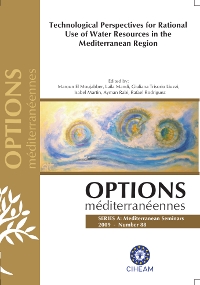| Article précédent | p. 231-239 | Article suivant |
Comparative analysis of water saving policies in agriculture: pricing versus quotas
The Water Framework Directive 2006/60/EC (WFD) recognizes the fact that water management should include an economic analysis of alternatives. In the present paper we propose a methodology based on comparative analysis to carry out an in-depth assessment of the socio-economic impact of two alternative water policies aimed at resource saving: i) water pricing policies (at basin and regional level) and ii) quotas (reduction in the abstraction of daily use). For this purpose, we implement a linear programming model at the territorial level to simulate the effects in terms of water saving and socio-economic impact. This is complemented by an aggregated analysis based upon crop water production and response functions. We analyze the implications of various water policies for the irrigation of one of the most important basins in Spain: the Guadalquivir Valley in Andalusia. The results indicate that application of quotas is more suitable than water pricing policies to achieve a reduction in water use and bring about economic sustainability.
La Directive Cadre sur l'Eau 2006/60/CE (DCE) reconnaît que la gestion de l'eau devrait inclure une analyse économique des alternatives existant dans ce domaine. Dans ce travail, nous proposons une méthodologie basée sur une analyse comparative qui évalue l'impact socio-économique de deux politiques alternatives visant à économiser l'eau : i) les politiques de tarification de l'eau (à l'échelle du bassin et de la région) et ii) les quotas (réduction du captage pour l'utilisation quotidienne). A cette fin, nous avons appliqué un modèle de programmation linéaire à l'échelle territoriale pour simuler les effets sur le plan de l'économie d'eau et sur celui des impacts socio-économiques. De plus, une analyse agrégée a été réalisée sur la base des fonctions de production et de réponsedes cultures à l'eau. Parallèlement, nous avons évalué les implications des diverses politiques de l'eau pour l'irrigation de l'un des principaux bassins hydrographiques espagnols : la vallée du Guadalquivir en Andalousie. Les résultats indiquent que l'application des quotas est un système plus performant que celui des tarifications pour réduire l'utilisation de l'eau et déterminer la durabilité économique.
- [ Afficher ]
- [ Télécharger ]
- [ Exporter la citation ]
Vous pouvez télécharger la citation au format :
- [ Imprimer ]
-
Mots-clés
CONSERVATION DE L'EAU, EVALUATION, FIXATION DES PRIX, GESTION DES EAUX, IRRIGATION, PROGRAMMATION LINEAIRECiter cet article
Giannoccaro G., Pistón J.M., SolvKolberg S., Berbel J. Comparative analysis of water saving policies in agriculture: pricing versus quotas. In : El Moujabber M. (ed.), Mandi L. (ed.), Trisorio-Liuzzi G. (ed.), Martín I. (ed.), Rabi A. (ed.), Rodríguez R. (ed.). Technological perspectives for rational use of water resources in the Mediterranean region. Bari : CIHEAM, 2009. p. 231-239. (Options Méditerranéennes : Série A. Séminaires Méditerranéens; n. 88). 2. MELIA Workshop Technological Perspectives for Rational Use of Water Resources in the Mediterranean Region, 2008/10/29-2008/11/02, Marrakesh (Morocco). http://om.ciheam.org/om/pdf/a88/00801198.pdf



